Yeovil People
Adam Gosney
Photographer
 Adam
Gosney
was born
in
Sherborne
in 1844,
one of
the
eight
children
of
labourer
Thomas
Gosney
(1813-1864)
and
Maria
née Dunell
(1810-1885).
In the
1861
census
Adam was
working
as a
servant
at
King's
School.
Adam
Gosney
was born
in
Sherborne
in 1844,
one of
the
eight
children
of
labourer
Thomas
Gosney
(1813-1864)
and
Maria
née Dunell
(1810-1885).
In the
1861
census
Adam was
working
as a
servant
at
King's
School.
Although Adam Gosney, seen at the left, was Sherborne born and bred and lived there all his life, his influence on the art of photography in Yeovil was substantial - warranting this page.
Gosney established himself as a photographer with a photographic studio initially in Long Street, Sherborne, moving to Half Moon Street, next door to the Plume of Feathers in 1873.
In 1875 he set up, and began advertising his 'New School of Photography' and around 1878 he probably purchased a mobile photographic studio and darkroom similar to the first image below. It is almost certain that he employed 'managers' to run his various branch and mobile studios.
Also in 1878, he purchased the photographic business of Cole & Son in Princes Street. The sale included all of Cole & Son's negatives as well as the negatives of their predecessor stone carver and photographer John Swatridge. In May 1879, Gosney advertised his new branch studio in Yeovil located at bookseller and stationer Mr Clark's premises in Middle Street.
Adam Gosney, in 1892, was described in an advertisement as ‘Photographic Artist, Carver, Gilder, Picture Frame Manufacturer, Established 1866’. He drew attention to his ‘Carbon Enlargements’, which, "when painted in oils combine the striking resemblance of photographs, with the breadth, effect, and permanency of first-class oil paintings". His charges were from ten shillings to five guineas ‘framed complete’.
He opened temporary studios several times in various towns and villages in the district - see the timeline below. By the 1890s he had permanent studios in Sherborne, Yeovil, Crewkerne, Dorchester and Gillingham. His Middle Street studio was taken over by Frederick Christopher in September 1896.
In the 1911 census, at the age of 66, he gave his occupation as 'Photographer and Frame Maker'. Gosney died at Half Moon Street, Sherborne, on 11 October 1921.
Studio TIMELINE
Adam Gosney established a number of permanent photographic studios but, at the same time, set up mobile photographic studios in various towns and villages throughout the area. It is assumed that Gosney personally ran his base studio in Sherborne while all branches, both permanent and temporary, were run by 'Managers' with, perhaps occasional visits by Gosney.
It is difficult to establish which of the following locations, apart from Yeovil and Sherborne, were permanent or mobile studios. Crewkerne, for instance, was initially served by a mobile studio in 1881, but a permanent studio appears to have been established in the town by 1883, albeit only open on Monday, Tuesday and Wednesday. By 1886, the Crewkerne studio was only open on Mondays.
The following timeline, extracted from various cartes de visite, advertisements and newspaper articles, gives a clue.
In the gallery, one is tempted to assume that cartes de visite with printed names of studios refer to permanent studios. However, I think the permanent studios were confined to Sherborne, Yeovil, Crewkerne, Dorchester, Wimborne and Wells - although not all survived throughout the period.
Mobile, or
temporary,
studios were at
various times
located at (in
alphabetical
order) Bruton,
Castle Cary,
Crewkerne,
Evershot, Frome,
Gillingham,
Ilchester, Mere,
Queen Camel,
Seaton,
Shaftesbury,
Shepton Mallet,
South Petherton,
and Stalbridge.
1866 -
Established his
studio in Long
Street,
Sherborne
1873 - Moved his
studio to Half
Moon Street,
Sherborne
1875 - Opened
the 'New School
of Photography.
opposite the
Town Hall,
Sherborne
1878 -
Sherborne,
Gillingham
(temporary
mobile studio),
Shaftesbury
(temporary
mobile studio)
1878 - Purchased
business of Cole
& Son with all
negatives and
negatives of
John Swatridge
1879 -
Sherborne,
Yeovil
1879 -
Sherborne,
Yeovil, Castle
Cary (temporary
mobile studio -
June, 14 days),
Bruton
(temporary mobile
studio - July,
14 days)
1881 -
Sherborne,
Yeovil, Mere
(temporary
mobile studio)
1881 -
Sherborne,
Yeovil,
Crewkerne
(temporary
mobile studio),
Gillingham
(temporary
mobile
studio)
1881 -
Sherborne,
Yeovil, Bruton
(temporary
mobile studio -
Sept "for a few
days")
1881 -
Sherborne,
Yeovil, Castle
Cary (temporary
mobile studio -
Oct "for a few
days")
1881 -
Sherborne,
Yeovil, Shepton
Mallet
(temporary
mobile studio -
November)
1882 -
Sherborne,
Yeovil, Queen
Camel (temporary
mobile studio -
Jan "for a few
days")
1882 -
Sherborne,
Yeovil, South
Petherton
(temporary
mobile studio -
March "for a few
days")
1882 -
Sherborne,
Yeovil,
Crewkerne
(temporary
mobile studio -
October "for a
few days")
1882 -
Sherborne,
Yeovil,
Shaftesbury
(temporary
mobile studio),
Seaton
(temporary
mobile
studio), Frome
(temporary
mobile studio)
1882 -
Sherborne,
Yeovil,
Ilchester
(temporary
mobile studio)
1882 -
Sherborne,
Yeovil, Frome
(temporary
mobile studio),
Gillingham
(temporary
mobile
studio), Bruton
(temporary
mobile studio)
1883, Sept -
Sherborne,
Yeovil, Mere
(these three
open daily.
Unless Gosney
had two mobile
studios, Mere must have
been a
short-lived
permanent studio), Crewkerne
(permanent
studio? Monday,
Tuesday & Wednesday),
South Petherton (temporary
mobile studio?,
Thursday,
Friday,
Saturday),
Gillingham
(temporary mobile studio, every
Monday)
1883, Dec -
Sherborne,
Yeovil,
Stalbridge
(these three
open daily, the
latter a
temporary mobile
studio), Crewkerne
(Monday, Tuesday
& Wednesday),
Evershot
(temporary
mobile studio,
Thursday, Friday,
Saturday),
Gillingham
(temporary
mobile studio,
every Monday)
1886, Jun -
(Somerset
Places) - Yeovil
(daily),
Crewkerne (every
Monday)
1889 -
Sherborne,
Yeovil,
Dorchester,
Crewkerne, Wells
(all permanent
studios)
1893 -
Sherborne,
Yeovil,
Dorchester,
Crewkerne,
Wimborne (all
permanent
studios)
1896, Sept - 19
Middle Street,
Yeovil, studio
sold. Gosney was
succeeded by
photographer
Frederick
Christopher.
Cartes de visite
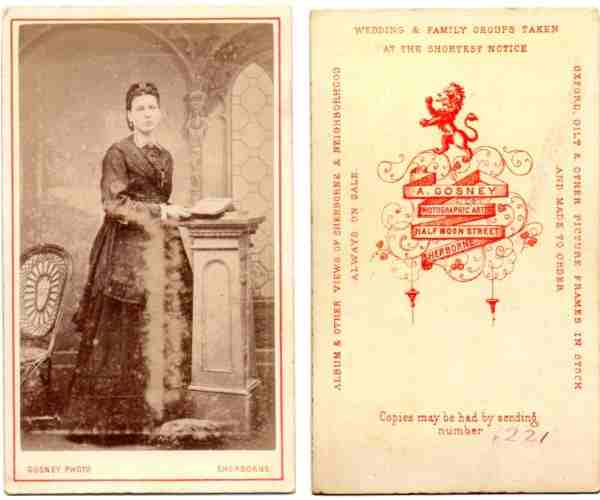
From my
collection
This carte de visite has the Half Moon Street address (therefore post-1873) but is from before the Yeovil studio opened (therefore pre-1879).
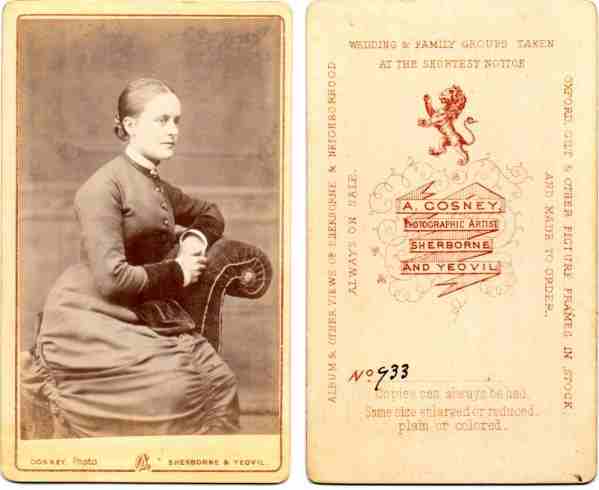
From my
collection
An almost identical back to the previous carte, however the crest now includes Yeovil - and therefore dates to around 1879 or 1880. The low re-order number 933 suggests that this is from the Yeovil studio.
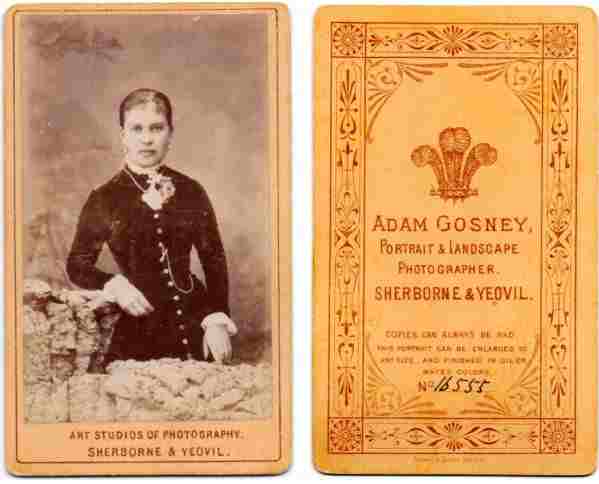
From my
collection
A post-1879 carte, after the Yeovil studio had been established. From this time onwards, until around the year 1900, Gosney used a range of printed card stocks. This example is by Prewer and Evans of London.

This colourised photograph
features in my
book 'Yeovil
From Old
Photographs'
Taken between 1879 and 1890, this carte de visite of South Street is by Adam Gosney shows the Greyhound Hotel at extreme right (before being rebuilt in its present form), the Cow Inn next door, the Globe and Crown opposite and the Three Choughs in the far distance at the end of South Street. Between the Cow Inn and the Choughs was the two-storey King's Arms (2) in the far distance as well as a couple of un-named beerhouses. Then the three-storey Market House Inn and then another un-named beerhouse. Just think, what an ideal pub crawl. Note the horse-drawn omnibus parked outside the Greyhound.
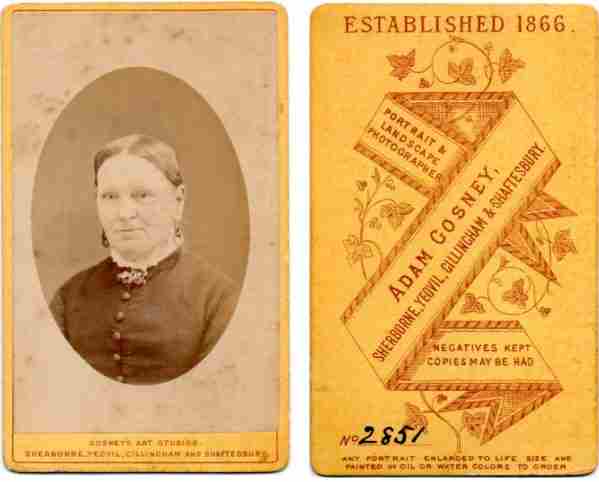
From my
collection
Although in my timeline above, Gillingham and Shaftesbury are listed as temporary mobile studios in 1878, this was the year before Gosney established his Yeovil studio. Both Gillingham and Shaftesbury are recorded as temporary studios in 1882, so this carte tends to suggest that mobile studio locations were sometimes included in the printing.
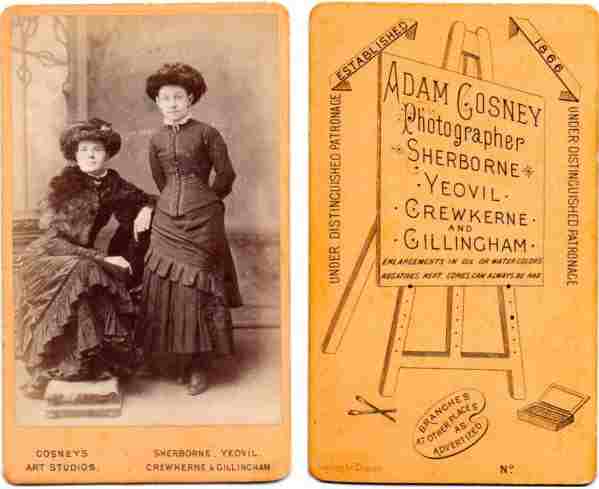
From my
collection
It is difficult to establish, but I believe this carte dates to around 1881 and that both Crewkerne and Gillingham were either temporary locations for the mobile studio or semi-permanent short-term studios in each town - presumably warranting the printing of the card stock. Crewkerne appears to have become a permanent studio around 1883.

From my
collection
It appears that Dorchester became the next permanent studio location and remained so throughout the 1890s. The card stock is from the Photo Stores, 45 Charterhouse Square. This carte probably dates to around 1889.
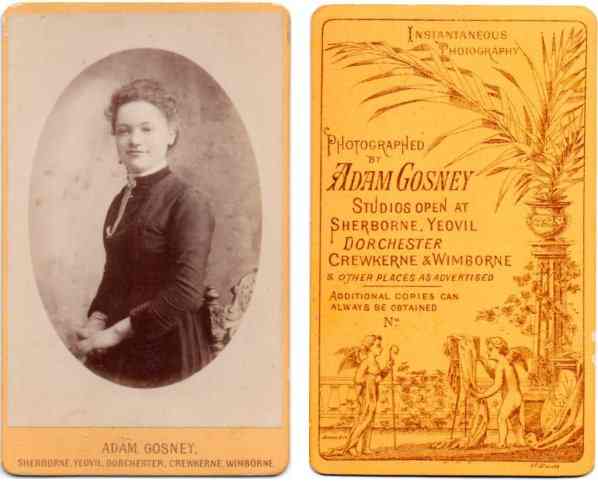
From my
collection
Adam Gosney regularly changed his card stock for the latest design. The card stock used for this carte is by Marion Imp. with the stock code Rd No 4058 dating to 1893. Ten of my Gosney's CDVs (about a third of my Gosney collection) are for studios at 'Sherborne, Yeovil, Dorchester, Crewkerne & Wimborne'. This set of studios employs several back designs, suggesting their use over two or more years and also suggesting that Wimborne became a permanent, albeit possibly short-lived, studio.
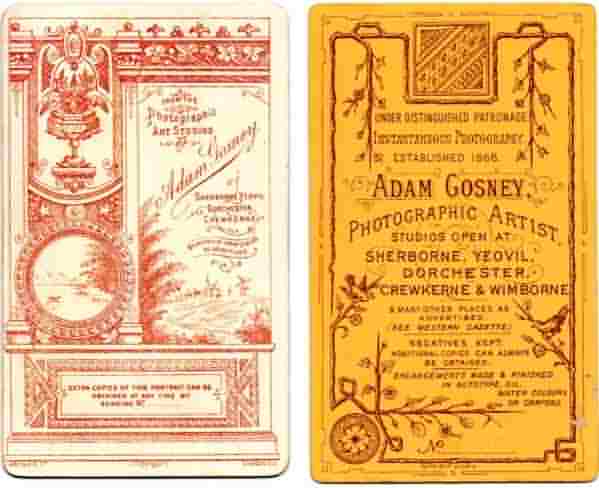
From my
collection
 From my collection |
Above
and at
left are
three
more
back
designs
used by
Adam
Gosney.
Above right was used for the Sherborne, Yeovil, Dorchester, Crewkerne and Wimborne studios. The carte at left, this example heavily trimmed to fit into an album, was used for the Sherborne, Yeovil, Crewkerne and Gillingham studios. It is a Marion Imp. stock design dating to around 1889.
|
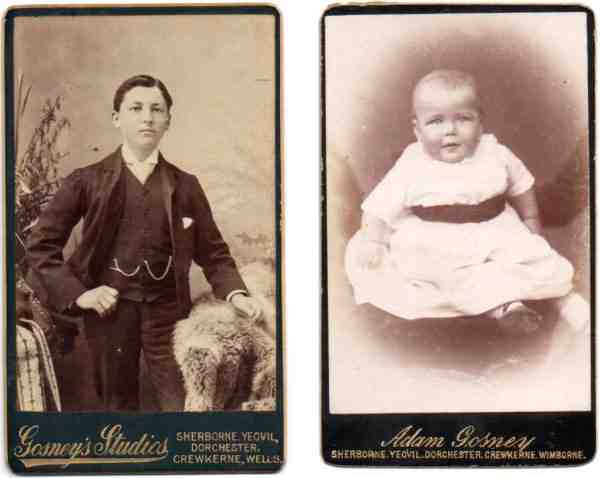
From my
collection
From the mid-1890s it became fashionable to have a plain-backed cardstock, usually with a very dark colour or black (as here) and the printing of the carte to only be on the front in gilt lettering and a gilt edge to the carte. Note that, above, the carte to the left includes Wells, while that to the right includes Wimborne.
gallery
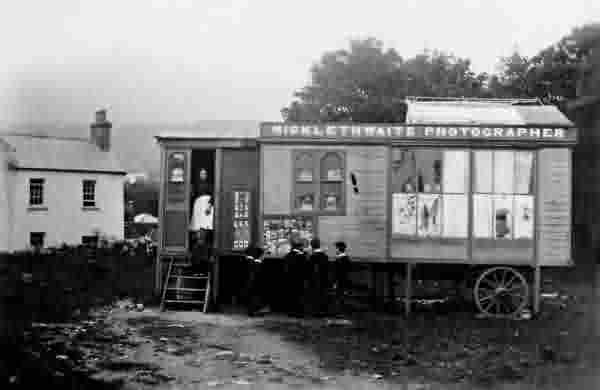
Mobile photographic studios and darkrooms appeared, such as this non-Yeovil example. It is clear that Adam Gosney would have used a similar portable set-up, or possibly in a tent (such as used by William Ross on Salisbury Plain during the Great War). He may even have hired space in existing buildings in various villages, although this is unlikely.
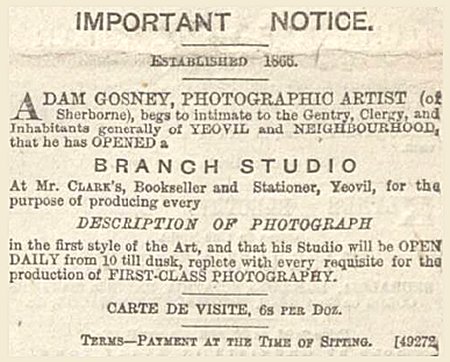
A notice placed in the 23 May 1879 edition of the Western Gazette informing the public of Adam Gosney's new studio opening in Yeovil.
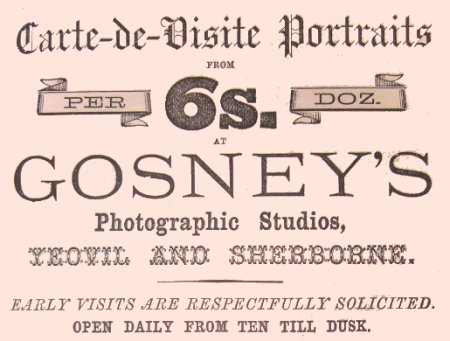
Adam Gosney's advertisement in Whitby's Yeovil Almanack Advertiser of 1880. The price of cartes de visite at six shillings per dozen equates to about £27 at today's value.

.... and his advertisement in the 1882 edition of Whitby's. The prices of 10s 6d to £5 5s 0d at today's value equate to about £45 and £225.
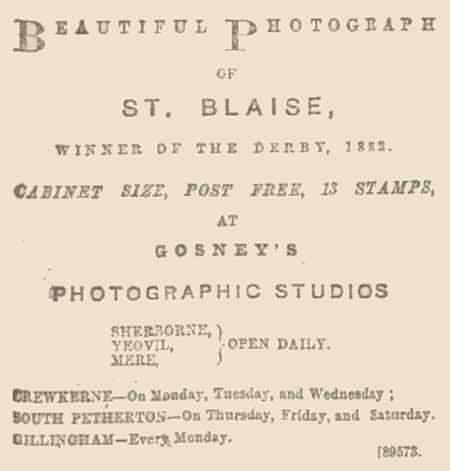
From the 7 September 1883 edition of the Western Gazette, this Gosney advertisement is typical and lists his studios with their respective days of opening.